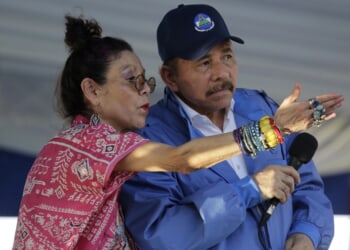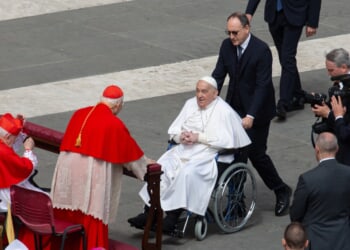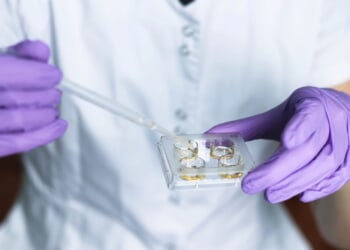
Pope Francis, the first Jesuit leader of the world’s 1.3 billion Roman Catholics and the first to come from the Southern Hemisphere, died Monday at age 88, the Vatican announced.
Francis entered Gemelli hospital on Feb. 14, 2025, for a respiratory crisis that developed into double pneumonia and, at 38 days, became the longest hospitalization of his papacy. Part of his right lung was removed in the late 1950s after a bout of pneumonia, and he suffered from chronic lung disease.
He emerged on Easter Sunday — his last public appearance, a day before his death — to bless thousands of people in St. Peter’s Square, drawing wild cheers and applause.
“At 7:35 this morning, the Bishop of Rome, Francis, returned to the home of the Father. His entire life was dedicated to the service of the Lord and of his Church,″ announced Cardinal Kevin Ferrell, the Vatican camerlengo, from the chapel of the Domus Santa Marta, where Francis lived.
His pontificate was marked by tremendous popularity among Catholics and non-Catholics alike, though not without controversy.
Liberals were disappointed that he didn’t move further and faster with reforms, while conservatives groaned under his overtures to make gay Catholics more welcome in the church while also restricting the use of the traditional Latin Mass, a rite his predecessor, the late Pope Emeritus Benedict XVI, permitted more widely.
Francis’ geopolitical views, particularly about immigration and capitalism, also ruffled feathers.
“One of the reasons he got elected is because I think the Cardinals from the global South saw him as an ally, somebody who had serious questions about globalization, was not enamored with the United States, and was critical of the impact of globalization on farmers and poor people,” said the Rev. Thomas Reese, a Jesuit priest and Religion News Service columnist.
Speaking in Bolivia in 2015, Francis said, “Once capital becomes an idol and guides people’s decisions, once greed for money presides over the entire socioeconomic system, it ruins society, it sets people against one another, it even puts at risk our common home, our sister Mother Earth.”
The following year, returning from the Mexican side of its border with the United States, Francis gave a remark widely interpreted as a knock on then-presidential candidate Donald Trump: “A person who only builds walls and not bridges is not [a] Christian.”
Francis received Mr. Trump at the Vatican in 2017, although several media accounts described it as a “frosty” encounter. Four years later, Joseph R. Biden, only the second American Catholic elected president, was more warmly greeted by the pontiff.
Mr. Biden, by his telling, received a commendation from the pope for being “a good Catholic” who should continue to receive Communion. The president had been criticized by conservative bishops and others for his pro-choice stance on abortion and was told not to present himself for Communion at some points on the 2020 campaign trail.
Humble persona
From the start of his papacy, the former archbishop of Buenos Aires, Argentina, maintained a humble and relatable persona that endeared him to millions.
“Brothers and sisters, good evening,” the new pontiff said to the throng gathered below the main balcony of St. Peter’s Basilica. The crowd later chanted “Francesco,” Italian for “Francis,” the name the former Cardinal Jorge Mario Bergoglio took in honor of St. Francis of Assisi, who left behind his riches to serve as a poor, itinerant preacher.
He rejected the traditional papal “apartment” in the Vatican’s Apostolic Palace to instead occupy a small room at a guest house used by other bishops and visiting clergy. He took his meals with others in the residence’s dining room. Initially, he selected a 2008 Ford Focus as his “Popemobile,” and was usually dressed in simple white vestments.
A few months after his election as Pope Francis in 2013, the man who was an Argentine cardinal just a year earlier answered an interviewer’s question, “Who is Jorge Mario Bergoglio,” directly.
“I am a sinner. This is the most accurate definition. It is not a figure of speech, a literary genre. I am a sinner,” he told Father Antonio Spadaro, a fellow Jesuit and La Civiltà Cattolica magazine editor.
His pontificate was marked by outreach to the disenfranchised and disaffected among the world’s Catholics. Asked early on about a gay cleric, Francis said, “If a person of homosexual tendency is honest and seeks God, who I am to judge him?”
Francis, returning from a trip to South Sudan in February 2023, said he opposed laws that criminalized homosexual conduct because LGBTQ individuals “are children of God [and] God loves them.”
But the pope was far less tolerant of the Latin Mass, which had largely been replaced by liturgies in a given locality’s language and where the priest faces the congregation. Traditionalists chafed at the change and were even more upset in 2021 when Francis said its use should be restricted.
The following year, Cardinal Wilton Gregory, archbishop of Washington, pared down the list of parishes permitted to use the rite to three, omitting District-based St. Mary Mother of God parish. Advocates of the traditional rite said the Chinatown parish had grown in recent years because of the Latin rite.
Although Francis’ positions on the environment and helping the poor were welcomed by the average pew-sitter, Father Reese said getting the whole church to follow the pope’s teachings was a different matter.
He said, “People like his pastoral approach to things; they like that he talks about God as compassionate and forgiving. They like it when he talks about concern for the poor and the marginalized. The disappointing thing for most Catholics is, when they go to church, they don’t find him in the pulpit.”
The Jesuit said the papacy “is an absolute monarchy tempered by selective disobedience on the part of the people of the church.”
Ex-bouncer before priesthood
The oldest of five children, Jorge Mario Bergoglio was born Dec. 17, 1936, in the Buenos Aires neighborhood of Flores to Mario José Bergoglio, an accountant who had emigrated from Italy, and Regina Maria Sívori, a homemaker. He has one living sibling: María Elena Bergoglio, who was born in 1948.
In December 2013, Francis told a group of Catholics at a church near Rome he had been a bar bouncer in Argentina. He also swept floors and worked in a chemical laboratory before his 1957 illness led to his joining the Jesuit order. He initially taught literature and psychology at Catholic high schools in Argentina before beginning theological studies.
Francis was ordained a priest in December of 1969. Four years later, on completing his spiritual training as a Jesuit, he was named the order’s provincial supervisor for Argentina. By 1992, he had become auxiliary bishop of Buenos Aires and became metropolitan archbishop in 1998.
Pope John Paul II created him a cardinal in 2001, and the then-Cardinal Bergoglio had been considered a candidate for the papacy in 2005 after the Polish-born pope died. Reports indicated that the Argentinian was the runner-up to Cardinal Josef Ratzinger, who became Pope Benedict XVI.
The two clerics would again cross paths when Benedict became the first pope to resign in 600 years and Francis was elected. They greeted each other warmly after the election and Francis insisted he often consulted Benedict, and that his predecessor agreed with the new pope on many decisions.
• This article was based in part on wire service reports.


![Jasmine Crockett Justifies Mass Illegal Immigration With Bizarre Argument [WATCH]](https://www.right2024.com/wp-content/uploads/2025/03/1742007023_Jasmine-Crockett-Justifies-Mass-Illegal-Immigration-With-Bizarre-Argument-WATCH-350x250.jpg)
![NYC Tourist Helicopter Falls into Hudson River, Siemens Executive and Family Among Those Killed [WATCH]](https://www.right2024.com/wp-content/uploads/2025/04/NYC-Tourist-Helicopter-Falls-into-Hudson-River-Siemens-Executive-and-350x250.jpg)
![Biden Drops Racial Slur During First Public Speech Since Leaving Office [WATCH]](https://www.right2024.com/wp-content/uploads/2025/04/Biden-Drops-Racial-Slur-During-First-Public-Speech-Since-Leaving-350x250.jpg)



![Green Day’s Cringe Trump Diss Ends in Fire and Evacuation [WATCH]](https://www.right2024.com/wp-content/uploads/2025/04/Green-Days-Cringe-Trump-Diss-Ends-in-Fire-and-Evacuation-350x250.jpg)
![Obama in 'Deeply Concerned' About Trump Removing Terrorist Sympathizers from Universities [WATCH]](https://www.right2024.com/wp-content/uploads/2025/04/Obama-in-Deeply-Concerned-About-Trump-Removing-Terrorist-Sympathizers-from-350x250.jpg)






